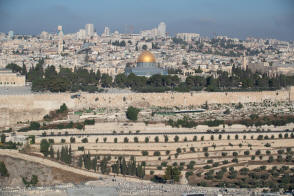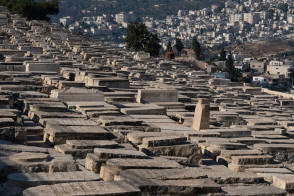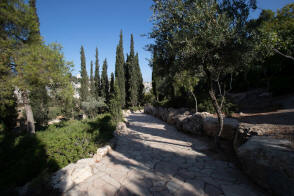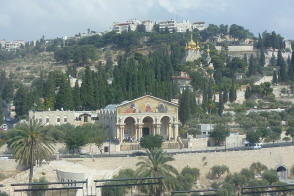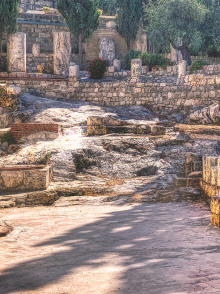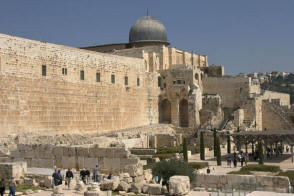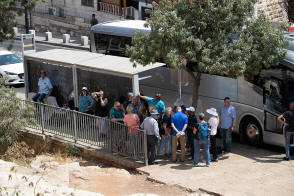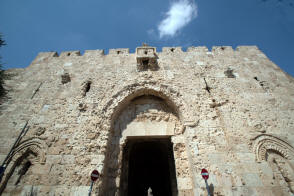JERUSALEM - THE MOUNT OF OLIVES AND GETHSEMANE - Friday, September 13. We had breakfast 6:45 and were on the bus by 7:40. We drove past the walled city and west across the Kidron Valley, which separates Jerusalem from the Mount of Olives. At about 8:00 the bus dropped us off quite far up on the Mount of Olives at a private memorial garden. There was a great view across the valley to the west wall and the Dome of the Rock. The entire hillside on our side was a vast necropolis. Burial on the Mount of Olives began some 3,000 years ago and is still going on. The cemetery is estimated to contain some 100,000 tombs.
Near the bottom, before we met the others (taxi riders), we
came to Gethsemane, the scene of Jesus’ Agony in the Garden. The size of the roots
on the olive trees was amazing. (Some have been carbon-dated back more than
900 years.) Close by, we visited the Basilica of the Agony (commonly called the
Church of All Nations), said to enclose that part of the garden where Jesus
prayed. (A short way up the hill from that was
the Church of Mary Magdalene, built in Russian Orthodox style.)
- THE CITY OF DAVID - We boarded our bus outside the Basilica at 10:15 and drove down the Kidron Valley to the City of David, now a National Park. This area (the Eastern Hill) has been heavily excavated since 1967 when the Israelis gained control of the area. It is believed to constitute the original settlement core of Bronze and Iron Age Jerusalem, and the city that King David captured about 1105 B.C., rebuilt, and made the capital of his only recently unified kingdom. Some Israeli archeologists claim to have identified specific features from David's time among the ruins, but most of these claims are disputed. As one might expect, casual tourists looking at 3,000 year old ruins should not expect to see much besides rubble. In some places, though, walls have been uncovered. In others, rubble has been restacked to show walls or other features. THE ARCHEOLOGICAL PARK Our bus next took us to the Jerusalem Archaeological Park, a huge multi-level excavation where the Western and Southern Walls of the Old City meet. The excavated ruins here were framed by the extant walls. Dominating the scene was the silver (really iron) dome of the Al Aqsa Mosque, high above us on the south end of the Temple Mount. (The golden Dome of the Rock, which shares the Temple Mount with the Mosque, was not visible from the Park.) There has been a mosque here since at least 700 A.D., but the present mosque dates from 1035. It is the third holiest site under Islam (after the Kabba in Mecca and the Prophet's Mosque in Medina). Excavation here began in ernest after Israel gained control of Jerusalem in 1967. There have been significant archaeological finds here from the various stages of the city’s history back to the First Temple period (1200-586 B.C.). Our group walked the length of Park, but we did not get to do much exploring. A large wedding party was starting to assemble on the main level, and we had to move to a more restricted higher level. Then there apparently a problem with the bus so we had to wait there for a call from Ronee.
Our
bus finally showed up at 12:45 and stopped in the middle of the street while we boarded. The bus
took us to lunch at Kibbutz Ramat Rachel. This Kibbutz (pop. 600) has a gold
mine feeding tourist groups. It is
actually located within Jerusalem's
municipal boundaries. The cafeteria
was super efficient; the food was
good; and the prices were reasonable
(for Jerusalem). It also operates a
hotel and a high-tech packging
business.
- THE UPPER ROOM - At 2:30 our bus took us to Mount Zion. We entered the Old City through the Zion Gate and walked a short way to the Cenacle (dining room), more commonly called the Upper Room. This is a room on the second floor of the David's Tomb Compound. (The traditional site of David's tomb is on the first floor.) The Upper Room is traditionally held to be the site of the Last Supper, as well as a common meeting place for the apostles in Jerusalem, and the place where the Holy Spirit alighted on the apostles on Pentecost. The mere grandeur of the columned marble interior raises doubts about the tradition, and archeological evidence suggests that the present building, at least, is not that old. As we left the Cenacle and walked across a large patio outside, one of the pastors in our group was suddenly inspired to stop and deliver a 20-minute discourse on his delight with the trip. While both interesting and impressive, the fact that we were out in the sun with no place to sit down was definitely a distraction. This time the bus was waiting for us, and we got back to the Dan Panorama Hotel at 3:30. Darrell went out briefly to see the King David Hotel (1931), just around the corner. Considered one of the world’s finest hotels, the King David has hosted royalty, heads of state, and numerous celebrities. Darrell was curious to see it because he remembered that, in 1946, a militant right-wing Zionist group (the Irgun) had detonated a large bomb in the hotel basement that destroyed much of the wing that housed the Headquarters of the British Armed Forces in Palestine, as well as the offices of the civilian administration. Ninety-one people were killed. We rested until the buffet dinner with the group at 6:30. There was a group meeting at 7:30. | |||||||

